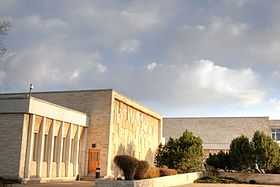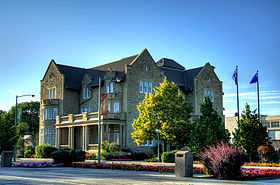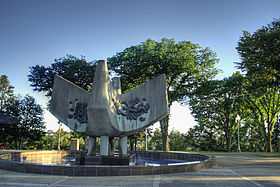Royal Alberta Museum
| Royal Alberta Museum | |
|---|---|
 | |
 Location in Edmonton
| |
| Established | 1967 |
| Location | 12845 102 Ave NW, Edmonton, Alberta, Canada |
| Coordinates | 53°32′35″N 113°32′39″W / 53.54294°N 113.54422°W |
| Type | History museum |
| Website | Royal Alberta Museum |
The Royal Alberta Museum is located in Edmonton, Alberta and was named the Provincial Museum of Alberta until 24 May 2005 when Queen Elizabeth II visited, bestowing royal patronage.[1] It has a natural history exhibit, a wildlife exhibit, an entomology exhibit, a Native Culture exhibit, as well as some smaller displays. It also houses an entomology collection and an arachnology collection. The museum was to undergo an extensive multi-million dollar renewal project, but funding has been put on hold causing delays.[2][3] Also on the premises is Government House which is used by the Alberta Government Caucus. The museum has three permanent galleries: Wild Alberta, Syncrude Gallery of Aboriginal Culture, and Natural History. The Museum also has rotating galleries that welcome travelling exhibits as well as host exhibits created in house by the museums curators.
History

The Federal Government’s confederation Memorial Centennial Program and the Government of Alberta began planning in 1950, but guided help was hired in 1962. Raymond O. Harrison was given 5 million dollars to find a site, hire staff and build collections in all of three years. It opened to the public December 6, 1967 as the Provincial Museum of Alberta, following a ceremony. The galleries presented opening day were fur trade, native peoples of Alberta, early photographs of aboriginals taken by Ernest Brown and Harry Pollard, agriculture, pioneer life, industry, commerce. The museum expanded through the 1960s and 1970s with more exhibits, curatorial programs and staff. The museum created many fine presentations, including: Australian Aboriginal Art, Japanese Kites, Log Cabin Construction, Highlights in the Search for Ancient Life, Bird Flight, Mammals of Alberta and Reefs.
Paid admission began in 1990, and to increase its audience the ground floor Indian Gallery was removed and the space used for feature exhibition space. Between 1989 and 2001 175 travelling exhibitions were displayed in this area. Some of which include: Prehistorics Gigantics (1990), Whales! Bigger than Dinosaurs (1992), Sharks: Facts and Fantasy (1993), Masters of the Night: The True Story of Bats (1994), Camosaurs! (1995), Bugsworld (1996), Genghis Khan (1997), Syria-Land of Civilizations (2001) and International Wildlife Photographer of the Year (2003).[4]
Mission
“To preserve and tell the story of Alberta - the experience of people and places over time - and inspire Albertans to explore and understand the world around them.”[5]
Vision

“To help Albertans play an active and informed role in shaping their world by encouraging understanding and appreciation of Alberta’s natural and cultural heritage.”[6]
Collection Organization
The collections are divided into four main categories: - Life Science: Botany, Ichthyology/Herpetology, Invertebrate Zoology, Mammalogy and Ornithology Program – 577,745 objects - Earth Science: Archaeology, Geology, Quaternary Paleontology, and Quaternary Environments - 9,224,075 objects - Human History: Ethnology, Cultural Studies (formerly Folk Life), Military and Political History (formerly Government History) and Western Canadian History - 137,610 objects - Collections Services: Collections Management, Conservation, Information Resource Management, Resource Library - 70,103 objects[7]
Wild Alberta Gallery
The Wild Alberta gallery contains dioramas, which show Alberta animals in replicated natural habitats. The gallery also gives visitors information on the ecosystems of Alberta and how animals, microorganisms and humans interact in the environment.
Syncrude Gallery of Aboriginal Culture
The gallery explores the history of North American Aboriginals with over 3000 artifacts spanning 11,000 years of history. It starts at the time of the last ice age, and explores aboriginal settlement, livelihood and culture.
James Carnegie Collection The museum bought items from the family of James Carnegie at a Sotheby's auction on 8 May 2006.[8] This was billed as the most significant auction of North American Indian artifacts to date, including a prized beaded dress collected in 1859 which cost USD $497,600.
Natural History Gallery
The Natural History Gallery is home to the popular "Bug Room" where some of the worlds largest bugs are on display.[9] The gallery also boasts an area dedicated to the vegetation of Alberta as well as the birds that make Alberta home. The entrance to the gallery houses a large geology exhibit containing exquisite gems and rocks, as well as a collection of the rocks that make up the landscape of Alberta.
Downtown building

In April 2011, it was announced that a new building for the Royal Alberta Museum would be built in downtown Edmonton, north of the city hall and Law Courts, and east of the CN Tower, on the land currently occupied by Canada Post's Edmonton station. The 36,000 m2 (390,000 sq ft) building, which will contain twice as much gallery space, is estimated to cost $340 million, and be completed in 2015. Premier Stelmach and the Alberta government have said that the location of the new building could be used for the terminal of an Edmonton—Calgary high speed rail line, while the old location will be the site for a new residence for the Lieutenant Governor.[10][11]
Images
-

Government House
-

Main entrance
See also
References
- ↑ Royal Alberta Museum. Royal Visit
- ↑ Royal Alberta Museum. Renewal project
- ↑ Archiseek. Royal Alberta Museum design revealed
- ↑ [* "Royal Alberta Museum Website"]. Retrieved 21 March 2012.
- ↑ [* "Royal Alberta Museum Website"]. Retrieved 21 March 2012.
- ↑ [* "Royal Alberta Museum Website"]. Retrieved 21 March 2012.
- ↑ [* "Royal Alberta Museum Website"]. Retrieved 21 March 2012.
- ↑ The Globe and Mail. Museum digs deep to acquire native artifacts
- ↑ http://www.royalalbertamuseum.ca/gallery/nathist/info.htm
- ↑ "Royal Alberta Museum to be built in downtown Edmonton". CBC News. April 7, 2011. Retrieved April 7, 2011.
- ↑ "Downtown Edmonton site of new RAM". Edmonton Journal. April 7, 2011. Retrieved April 7, 2011.
External links
| ||||||||||||||||||||||||||

